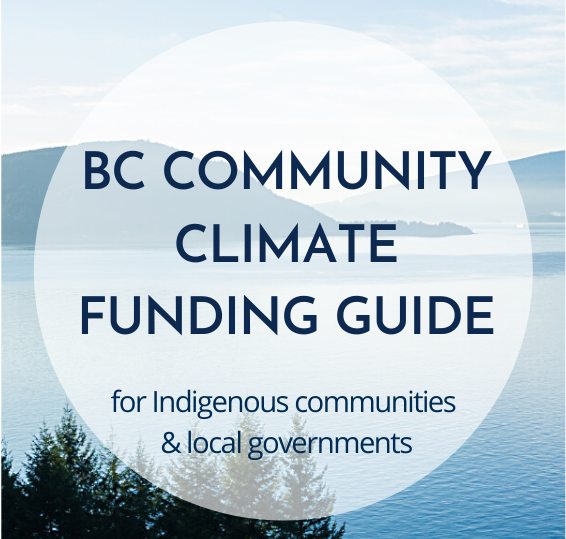Community Clean Energy Project Examples
Every community has distinct energy needs and opportunities. Below are a few examples of community energy projects that were developed to support with clean energy generation and energy efficiency in communities.
Energy Generation Projects
Renewable energy systems for buildings
On-site renewable energy, such as solar or wind power, is a way to power buildings in communities while reducing reliance on fossil fuels and minimizing greenhouse gas emissions. These technologies have an important role in meeting energy needs throughout the Province.
- Tsleil-Waututh Nation (TWN) fixed solar PV array that will generate up to 41.6kW of power, or approximately 46,700 kWh of electricity, as a demonstration of solar energy integration into a new community building. The project worked with TWN staff in the installation and operation of renewable energy infrastructure, with two TWN staff being provided 14 days training during the installation process. This project displaces 120 tonnes of CO2e annually.
Neighbourhood energy systems
District or neighbourhood energy systems use locally available renewable resources to provide heat and cooling to near-by buildings. It does this through a centralized network of underground pipes carrying hot water, steam, or chilled water from a central plant.
- Cutting emissions by over 60% at False Creek, Vancouver: The False Creek Neighbourhood Energy Utility uses waste thermal energy captured from sewage to provide space heating and hot water to buildings in the False Creek area. This recycled energy eliminates more than 60% of the greenhouse gas pollution associated with heating buildings. A 2018 expansion now serves 2,100,000 m2 (22,600,000 ft2) and achieves a 14,000-tonne reduction of CO2-equivalent per year. The utility is self-funded, simultaneously providing a return on investment to City taxpayers and affordable rates to customers.
- Gaining efficiencies by expanding to sewer heat recovery: Richmond’s Oval Village District Energy Utility (OVDEU) is a district energy system which uses two central Heating plants to provide heating and domestic hot water. The OVDEU currently reduces greenhouse gas emissions by an estimated 400 tonnes of CO2-equivalent per year. This reduction will increase significantly in phase two, when the OVDEU will recover heat from a local sewer system.
Community energy systems
Community energy systems locally generate and deliver energy with greater efficiencies and lower emissions than individual furnaces, boilers, electric baseboards, and water heaters fuelled by oil, natural gas, propane, or electricity.
- Ah’ta’apq Creek Hydropower Project: A 350 kilowatt hydropower project is located near Hot Springs Cove and aims to help the Hesquiaht First Nation’s remote Clayoquot Sound community transition from diesel. Once completed, it is expected to reduce the community’s diesel consumption by 80 per cent and reduce the community’s greenhouse gas emissions by approximately 20,000 tonnes of CO2-equivalent throughout the facility’s lifetime.
- Kitasoo/Xai’xais First Nation Battery-power Storage Bank: The Kitasoo/Xai’xais First Nation completed a project to install a battery power storage bank and control system with a 125-kilowatt-hour storage capacity. The system operates interactively with the existing hydroelectric facility to improve the efficiency of water usage and to help address any impacts to water availability for power generation due to climate change. This system will reduce the use of supplementary diesel generators leading to reductions of 159 tonnes of CO2-equivalent per year.
- Local biomass energy centre at Sicamous: The District of Sicamous built a Biomass Energy Centre, consisting of a biomass heating boiler system and a boiler house. This innovative technology uses wood waste, which is repurposed as fuel for the biomass system replacing existing electricity, propane and oil heating systems and reducing emissions by 300 tonnes of CO2-equivalent per year.
Energy Efficiency Projects
Programs dedicated to energy efficiency and conservation are integral to meeting British Columbia's future energy needs. The BetterHomesBC and BetterBuildingsBC websites are B.C.’s online hub for home owners, businesses and Indigenous communities to access information, incentives and support to reduce energy use and greenhouse gas emissions in new and existing homes and buildings.
- Hartley Bay Heat Pump Initiative: The project was conceived by Gitga'at First Nation and supported by BC Hydro and the Province of BC through the Indigenous Community Energy Coach and Heat Pump Incentive program. The community prioritized installing energy efficiency technologies to reduce diesel use for electricity generation in every house and in all community buildings, including the Hartley Bay nursing station. A total of 67 buildings were equipped with heat pumps in the community and are expected to achieve a significant reduction in CO2 emissions.
- District of Summerland: The District of Summerland added heat pumps to their wastewater treatment plant (their most energy-intensive major facility) and reduced their energy use by almost 800 gigajoules annually and emissions by 39.2 tonnes of CO2-equivalent per year.
B.C. Community Climate Funding Guide for Indigenous communities & local governments. An all-in-one online guide of funding opportunities for climate action projects in your community.
Contact information
Please email the Community Clean Energy Branch for more information.

